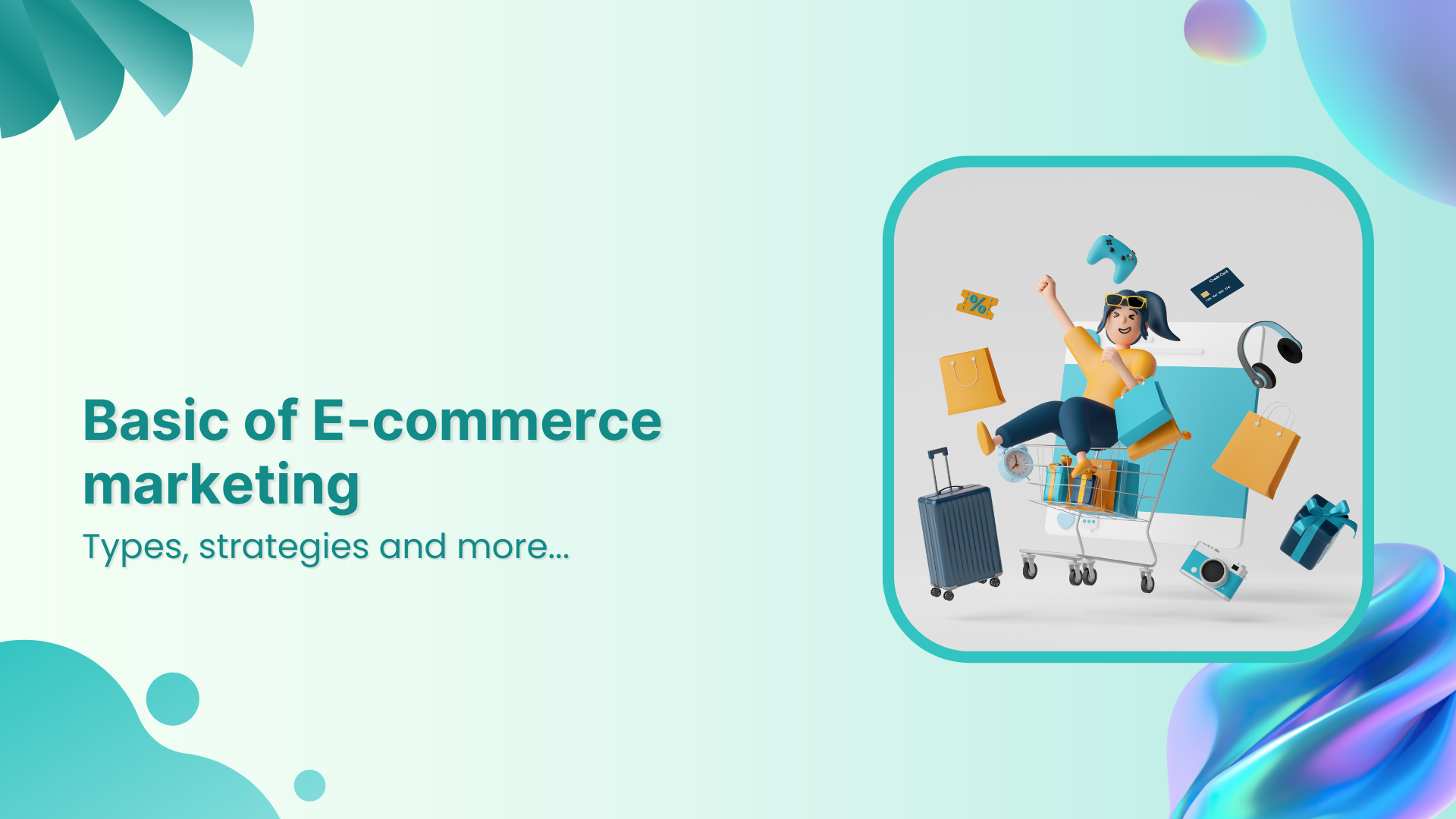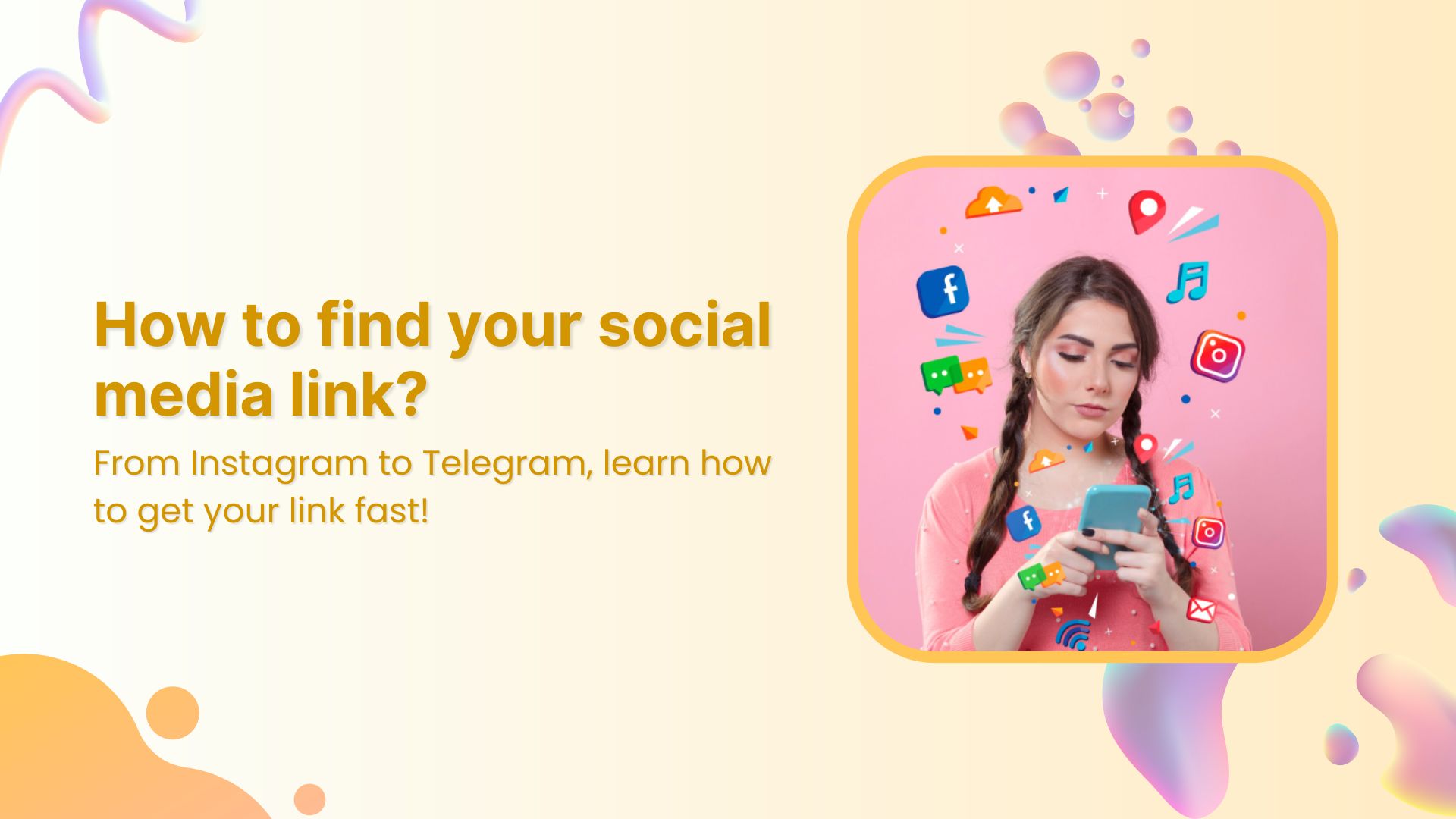E-commerce marketing refers to the strategies and tactics used to drive traffic to your online store, convert that traffic into paying customers, and retain those customers post-purchase.
E-commerce growth is on the rise across the globe and will continue to get bigger over the next few years.
There are over 2.77 billion online shoppers worldwide that have opened the e-commerce gateway wide open not just for themselves, but also for manufacturers, retailers, and marketers.
It’s no surprise that e-commerce marketing is crucial to putting an e-commerce business on a success trajectory.
When did e-commerce take off?
E-commerce started in 1982 with the launch of Boston Computer Exchange, an online marketplace for individuals to buy and sell used computers.
Things started to change in the global e-commerce landscape in the 1990s. E-commerce companies like Amazon and eBay emerged, significantly shaping the e-commerce landscape we recognize today.
In May 1989, Sequoia Data Corp. introduced Compumarket, marking the inception of the first internet-based system for e-commerce. This platform allowed sellers to list their items and buyers to search the database and make purchases using credit cards.
E-commerce became accessible for small and medium-sized businesses with the inception of the web in the 1990s. Tim Berners-Lee developed the first web browser, WorldWideWeb, on a NeXT computer, further propelling the growth of e-commerce.
Additionally, innovations like software for estimation and costing allowed businesses to streamline their operations, making it easier to manage pricing and project calculations within the e-commerce infrastructure.
Related: How to Build a Successful E-commerce Website
What is e-commerce marketing?
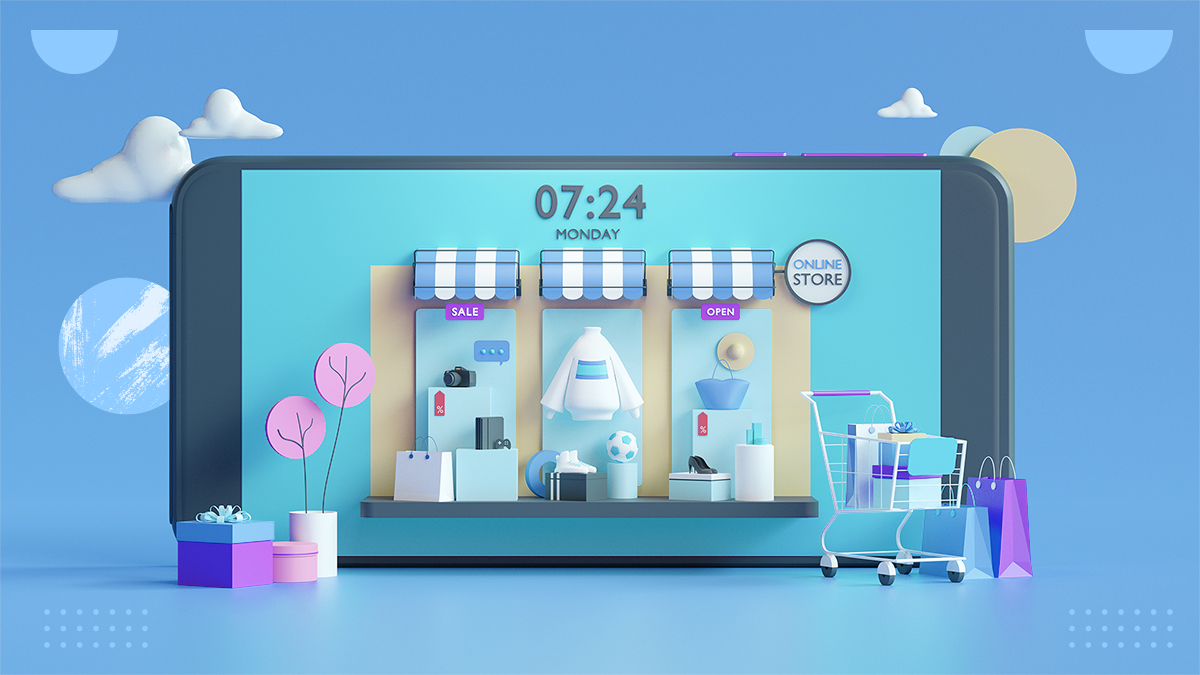
E-commerce marketing refers to the strategy built and implemented by e-commerce businesses to attract, engage, and convert the audience by utilizing multiple channels, such as social media content, paid ads, and influencer marketing.
The goal is to engage as many people as possible through email, social, and paid ads and make your e-commerce brand get noticed by the audience.
E-commerce marketing is putting your e-commerce brand out there, attracting new eyeballs, building connections, and improving ROI along the way.
The upside of running a successful e-commerce marketing campaign is that the e-commerce store doesn’t only generate sales but also builds brand awareness among the masses.
Convert your followers into customers with single bio link.
Uplift your conversion rates by connecting all of your social accounts and business pages with a single bio link.
Get Started For Free!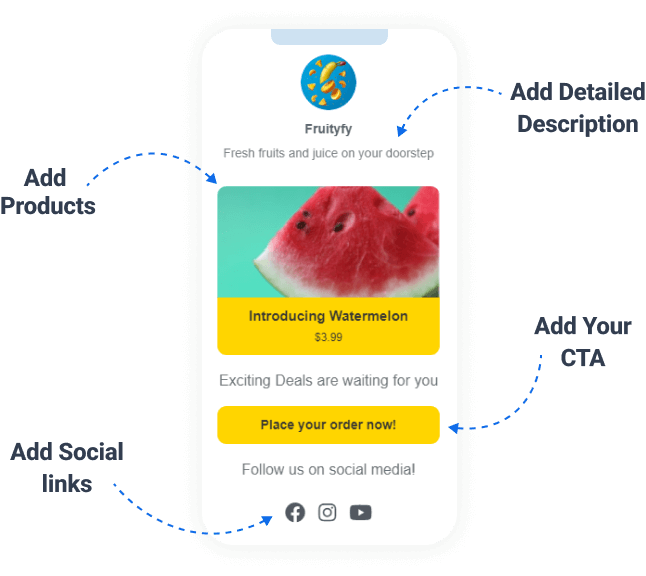
Why e-commerce marketing is important
Marketing is as important for an e-commerce brand as it is for any other type of business. Digital marketing doesn’t only provide sales opportunities to brands, but it also opens a portal to showcase creativity through content, copy, ad designs, etc.
The concept behind e-commerce marketing is to put forth the products in front of the audience for engagement, establish brand positioning, and improve conversion eventually.
As consumer expectations evolve rapidly, successful marketing today is about delivering the right message to the right person at the perfect moment. This is where AI in eCommerce becomes a game-changer helping brands unlock predictive insights, create hyper-personalized campaigns, and automate repetitive tasks to stay ahead in a crowded digital space.
The reason why e-commerce marketing is emphasized enough by industry experts is that we’re living through a busy, noisy time where users’ attention spans have been significantly squeezed. The aim is to explore every alternate channel that pops up in the market and plays an anchor role in finding untapped marketing opportunities.
You may also like: Top 11 benefits of eCommerce SEO
What are the 5 C’s of e-commerce marketing?
Let’s discuss the 5 C’s of e-commerce marketing that are worth analyzing:
1. Company
The first ‘C’ indicates the company itself. It involves building a brand identity by establishing a recognizable business name and crafting a crystal clear business profile that outlines who you are, what you do, and where you’re based.
It’s essential to dig deep into the fundamentals (to analyze your company) to pinpoint your competitive advantages, which describe brand strength, capability, and efficiency. Customers need to see that your company has a sustainable edge over competitors.
2. Context
Marketing isn’t completed without infusing psychology into the sales tactics. Understanding the context revolves around knowing your customers’ desires, purchasing motivations, and actions.
The idea is to provide experiences that fulfill their emotional and practical needs. Grasping consumer behavior–what they want, why they need it, when and where they prefer to buy–is crucial to winning in this business model.
E-commerce marketing is all about addressing the aspects of products that are a game-changer for the audience, but it won’t be possible without knowing the context inside-out.
3. Competition
Competition can both challenge and opportunity for businesses. By paying close attention to competition, one can understand what customers want and identify their unique advantages.
Generally, competition in the e-commerce market can be intense, but it also offers opportunities to refine your strategies and surpass rivals. This is where new e-commerce marketing ideas are born. Understanding whether Shopify or Amazon is the right fit for your business can also inform your competitive strategy.
4. Consumer
Consumers are the center of attention in any marketing strategy – e-commerce marketing is no different. It’s crucial to understand their needs, requirements, and expectations to make a difference.
What do customers want? They want the best products and services at competitive prices.
One of the e-commerce marketing strategies brands can adopt is to expand their reach, engagement, and customer base by actively engaging on social media platforms where their target audience shows up or building marketing strategies that attract potential customers, for instance, a lot of brands use YouTube or Instagram to announce their giveaways.
5. Collaboration
E-commerce marketing and collaborations go hand-in-hand. Brands collaborate with influencers and industry experts to pick their brains and provide value to the audience.
Undoubtedly, collaborations are essential for reaching new audiences across all social media platforms. Partnering with social media influencers or top industry experts can expose your brand to their followers as well.
What are the 7 P’s of marketing in e-commerce?
Here are the 7 P’s of marketing that are crucial in e-commerce:
1. Product
The product is the fundamental element of these 7 P’s of marketing. If there is no product, then there is nothing to market. So, start by choosing your product to market. Usually, product selection isn’t an issue for companies because they always have a product or service to sell.
2. Price
The next important section of the 7’s of marketing is the price. It’s something that customers always check before they go ahead and add a product to the shopping cart. An e-commerce store must be aware of the similar product prices on the competitors’ sites. Moreover, sometimes companies use discount offers to attract customers and get their attention – it mostly works.
3. Promotion
Promotion is yet another important element of the 7’s of marketing. It’s related to the process of communicating with potential customers through different channels. The purpose of the promotion is to ensure that the offer is seen by the prospective audience.
4. Place
Place refers to the real estate where the brand can reach out to the audience and connect with the prospects. It’s the distribution channels where the action occurs; it could be the online store, a physical store, or the social media page.
5. People
Companies aren’t just fancy offices where employees work — people behind those walls are the company. People matter whether employees, customers, or other stakeholders in the organization. Understanding and valuing the human factor plays a vital role in succeeding marketing campaigns.
6. Packaging
Packaging refers to the branding and outlook of the brand. One must ensure that the physical appearance of the products aligns with the image created by the brand or the perception is given to the end-users.
7. Process
The process is an essential part of the 7P’s of marketing as it covers areas like logistics, delivery of the product/service, and correspondence with the customers. Streamline the processes as smoothly as possible for the customers. Companies that invest in process efficiency see significant improvements in customer satisfaction and operational costs while maintaining high service standards. This includes implementing tools and techniques that increase team productivity, leading to faster, more efficient service. To further enhance your e-commerce operations, it is essential to optimize your delivery routes effectively.
Create compelling Call-to-Actions to boost conversions
Improve your click through rate by creating catchy CTAs for your marketing campaigns.
Get Started For Free!
The most common e-commerce marketing channels and key tips
Let’s be honest, tons of marketing channels can be used to promote e-commerce businesses. However, some of them seem outdated nowadays. Let’s shed some light on the ones that are relevant these days:
1. Social media

Social media marketing, complemented by emerging technologies such as voice AI generators, turns out to be the most effective marketing channel for e-commerce businesses. By incorporating interactive and engaging voice-driven content, e-commerce companies are not only building an audience across all social platforms but also significantly enhancing user engagement, leading to deeper community connections.
Social media platforms are powerful tools for reaching and engaging with your audience. Key tips include:
- Platform selection: Choose platforms where your audience is most active, such as Facebook, Instagram, or Pinterest.
- Content strategy: Share a mix of product promotions, user-generated content, and behind-the-scenes looks.
- Paid advertising: Use targeted ads to reach potential customers and retarget those who have interacted with your brand.
- Influencer marketing: Partner with influencers to expand your reach and build credibility.
The ROI of social media marketing is fascinating if it’s done right. No wonder every major e-commerce is trying to hop on every mainstream social media platform like Facebook, Twitter, LinkedIn, Pinterest, Instagram, and TikTok.
Related: How to Measure Social Media Engagement
2. Paid ads
E-commerce brands squeeze every bit of opportunity they get on the internet to put their brand out there and generate e-commerce sales.
Paid advertising can help you quickly reach a larger audience and drive traffic to your store. Common paid advertising tips include:
- Google ads: Use different types, including search ads, display ads, or shopping ads, to reach potential customers.
- Social Media ads: Run targeted ads on platforms like Facebook, Instagram, or LinkedIn.
- Retargeting ads: Re-engage visitors who have left your site without making a purchase.
- Affiliate marketing: Partner with affiliates who promote your products in exchange for a commission on sales.
3. Email marketing
Email marketing refers to the marketing done through email newsletters. E-commerce companies are big on email marketing. They use email marketing to upsell, retarget, and promote new offers.
Email marketing remains one of the most effective channels for driving sales and building customer loyalty. With the right balance of generative AI use, you can circle this channel efficiently. Common email marketing tips include:
- Segmentation: Divide your email list into segments based on customer behavior, demographics, or purchase history.
- Personalization: Use customer data to personalize email content, such as product recommendations and special offers.
- Automation: Set up automated email sequences for abandoned carts, welcome series, and post-purchase follow-ups.
- Promotional campaigns: Run seasonal promotions, flash sales, or special discounts to drive conversions.
Related: 6 Effective Email Marketing Strategies for SAAS Businesses
4. Search engine optimization (SEO)
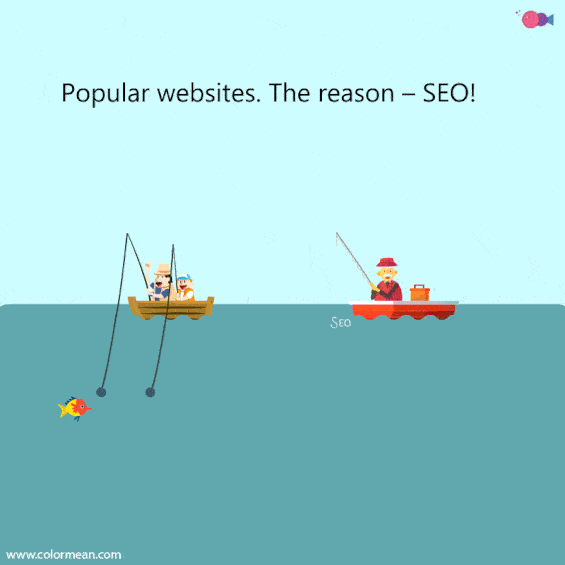
SEO is crucial for eCommerce businesses to improve their visibility in search engine results. Key SEO tips include:
- Keyword research: Identify relevant keywords your potential customers are searching for.
- On-page optimization: Optimize product pages, meta descriptions, and headlines with targeted keywords.
- Technical SEO: Improve site speed, mobile responsiveness, and ensure proper indexing.
- Content marketing: Create valuable content that drives organic traffic and builds brand authority.
Use deep links for seamless navigation Trigger more clicks, conversions & app installations with fully customizable deep links.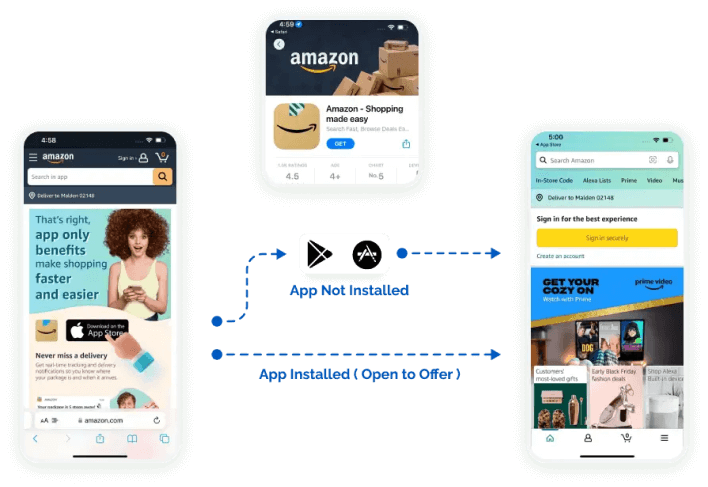
5. Content marketing
Content marketing is yet another marketing channel that businesses, individuals, influencers, and entrepreneurs use to spread the word about their expertise, products, and offers.
Content marketing is a marketing strategy that allows marketers to use content, such as articles, videos, podcasts, and images to market their product or service.
Effective content marketing tips include:
- Blogging: Write blog posts that address customer pain points and provide solutions.
- Product guides: Create detailed guides that showcase how your products solve specific problems.
- Video marketing: Use AI videos to demonstrate product features, share customer testimonials, or provide tutorials.
- Infographics: Visual content that simplifies complex information, making it easier to understand and share.
6. Influencer marketing

Influencer marketing has become extremely popular among millenials and Gen Z popular. We won’t be surprised if these generations are more crazy about top YouTubers and TikTokers than A-list Hollywood celebs.
This opens a doorway of marketing opportunities for e-commerce companies to collaborate with content creators and social media influencers and market their products. Key tips include:
- Partnerships with influencers: Collaborate with influencers who have a relevant audience that matches your target market.
- Content creation: Work with influencers to develop authentic content, such as reviews, tutorials, or lifestyle posts, that naturally features your products.
- Audience engagement: Utilize the influencer’s platform to engage with their followers, increasing brand visibility and trust among potential customers.
Related: Top 10 Ecommerce Influencers You Should Follow
7. Affiliate marketing
Affiliate marketing is a highly effective eCommerce marketing strategy where businesses partner with affiliates who promote their products in exchange for a commission on sales or leads generated. This strategy leverages the influence and reach of affiliates to drive traffic, increase sales, and expand the brand’s visibility with minimal upfront costs.
Key affiliate marketing tips include:
- Identify the right affiliates: Choose affiliates who align with your brand and have a following that matches your target audience.
- Offer competitive incentives: Attract high-performing affiliates by offering competitive commissions and bonuses for top performers.
- Monitor and optimize: Regularly review affiliate performance data to identify top performers and areas for improvement. Optimize your strategy based on these insights.
Related: How to Create Affiliate Links and Keep Track of Affiliate Results?
Key e-commerce marketing strategies to apply
Let’s take a quick look at some of the best e-commerce marketing strategies you can apply to any e-commerce business whatsoever:
- Create content consistently, so that your brand stays relevant regardless of the platform. Choose whatever is working for you whether it’s the blog, social, or email – just double down on what brings in the dollars.
- Keep experimenting with your social media content by changing style, format, and approach. Everyone loves the newness and change. Stick with your branding, but keep bringing new flavors to the table.
- Use every social media feature available at your disposal on your chosen social media platforms, such as Stories, Live streams, Shorts/Reels, etc. There is a reason why influencers try out every new tool that comes out on any social media platform.
Related: 5 Expert Tips For Optimizing Your eCommerce With Videos
- Establish a powerful, synchronized email marketing system that keeps new customers, cart abandoners, and existing customers all in the loop.
- Test out new marketing strategies for your e-commerce business, such as influencer marketing and affiliate marketing, and see how they work out for you.
- Monitor your e-commerce store statistics, especially after making changes in the UI/UX, social media marketing, and content creation.
Related: Top 7 E-commerce Payment Trends of 2024
What are the four major e-commerce business models?
Four main e-commerce business models are worth knowing:
1. Business-to-Consumer (B2C)
B2C is the most common e-commerce business model in which businesses sell products or services directly to consumers. The B2C e-commerce business model examples include online retailers like Amazon and Walmart.
2. Business-to-Business (B2B)
In the B2B model, businesses sell goods or services to other businesses. It typically involves larger transactions and longer sales cycles. The B2B e-commerce business model examples include wholesale suppliers or companies like Alibaba and Grainger.
3. Consumer-to-Consumer (C2C)
The consumer-to-consumer (C2C is also known as the peer-to-peer model. It allows consumers to sell products or services to other consumers, with online platforms facilitating these transactions. Examples of this business model are eBay, Craigslist, and other classified ad sites.
4. Consumer-to-Business (C2B)
Consumer-to-business is a lesser-known e-commerce business model in which individuals sell products or offer services to businesses. The prime examples of this business model are platforms like Freelancer, Upwork, and Fiverr where freelancers provide services to businesses.
Each of these e-commerce business models caters to different types of consumer segments, offering unique value to the businesses.
Link Management Made Easy
Your go to link management tool for CTAs, branded and bio links, QR Codes, tracking and retargeting.
Get Started for FREE!
Top e-commerce platforms
- Shopify: Known for its user-friendly interface, Shopify offers a complete eCommerce solution with customizable templates, payment processing, and extensive app integrations.
- WooCommerce: A flexible, open-source eCommerce plugin for WordPress, WooCommerce is ideal for businesses looking for customizable options and control over their online store.
- Magento (Adobe Commerce): A powerful platform suited for large-scale businesses, Magento offers extensive features, scalability, and customization options.
- BigCommerce: A robust eCommerce platform that supports businesses of all sizes, offering built-in features for SEO, multi-channel selling, and analytics.
- Wix eCommerce: Known for its drag-and-drop website builder, Wix eCommerce is a good option for small to medium-sized businesses looking for an easy-to-use platform.
- Squarespace: Popular for its visually appealing templates, Squarespace is a great choice for businesses focused on design and aesthetics.
- PrestaShop: An open-source eCommerce solution that offers a high degree of customization, PrestaShop is ideal for businesses with technical expertise.
- Salesforce Commerce Cloud: A scalable platform for enterprises, offering personalized experiences, AI-driven insights, and integration with other Salesforce products. Additionally, it leverages cloud services to ensure high availability and enhanced performance for users worldwide.
- OpenCart: Another open-source platform, OpenCart is lightweight and easy to manage, with a wide range of extensions available for customization.
- Volusion: A cloud-based eCommerce platform designed for small businesses, offering tools for inventory management, payment processing, and analytics.
Related: Top 7 E-commerce Payment Trends of 2024
Major e-commerce marketing challenges in the digital era
- Increased competition: The digital landscape is crowded with eCommerce businesses, making it harder to capture and retain customer attention.
- Ad fatigue and rising costs: Consumers are bombarded with online ads, leading to ad fatigue, while the cost of digital advertising continues to rise.
- Data privacy and security: Balancing personalized marketing with data privacy concerns and compliance with regulations like GDPR is increasingly difficult. Tools like VPNs, 2FA, and encrypted digital vaults help secure platforms and build trust.
- Adapting to changing algorithms: Search engines and social media platforms frequently update their algorithms, affecting visibility and reach.
- Mobile optimization: With more consumers shopping on mobile devices, ensuring a seamless mobile experience is crucial but challenging.
- Customer retention: High customer expectations and numerous options make it tough to build and maintain customer loyalty.
- Omnichannel marketing: Coordinating consistent and effective marketing across multiple digital channels requires sophisticated strategy and technology.
- Technology integration: Integrating new tools and platforms into existing systems can be complex and costly.
- Logistics and supply chain management: Efficiently managing inventory, shipping, and returns while keeping costs low is essential but challenging.
- Globalization: Expanding into international markets brings challenges with cultural differences, language barriers, and local regulations.
Future trends in e-commerce marketing
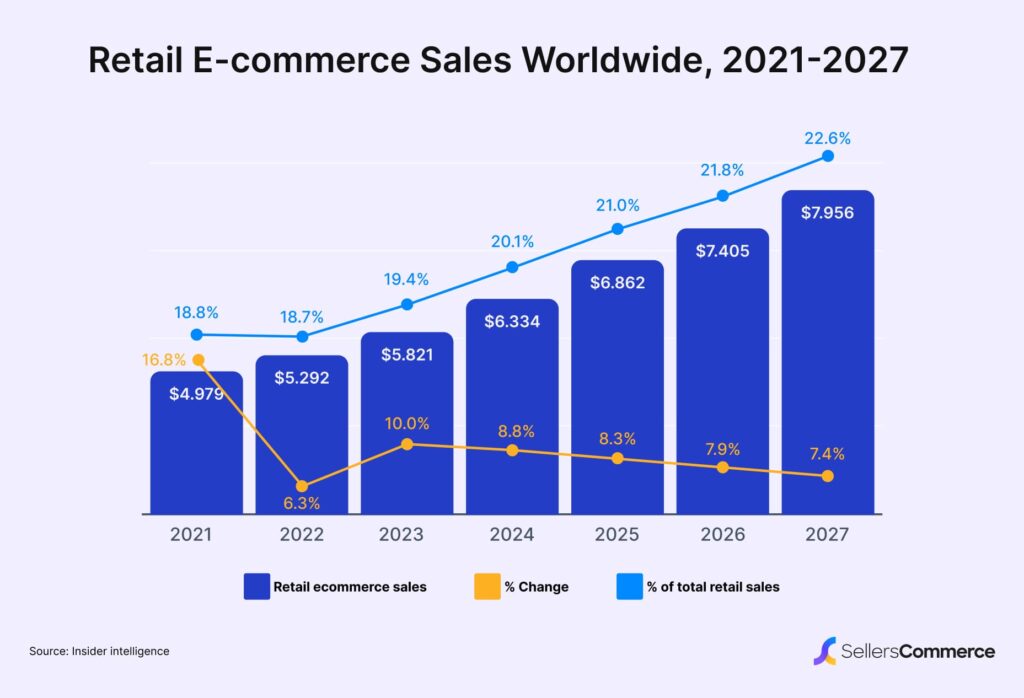
E-commerce seems to be on the rise ever since the Covid-19 pandemic hit the world. With the advances of new e-commerce platforms that have eliminated the barrier to entry in e-commerce to a great extent, it’s not hard to predict the future trends in the e-commerce industry.
It’s expected that the global retail e-commerce sales expected to reach 8 trillion dollars by 2027. It’s a mind-boggling statistic to comprehend.
While there would be challenges for starters and e-commerce store owners would still give up on their e-commerce dreams, it looks like the most exciting time to be alive and build a future in the e-commerce realm.
Link Management Made Easy
Your go to link management tool for CTAs, branded and bio links, QR Codes, tracking and retargeting.
Get Started for FREE!
FAQs about e-commerce marketing
What is meant by e-commerce market?
The e-commerce market refers to the online marketplace where businesses and consumers buy and sell goods and services over the internet. It encompasses all online transactions, including retail shopping, digital products, and services.
What are the 4 F’s of digital marketing?
The 4 F’s of digital marketing are:
- Findable: Making your content easily discoverable through search engines and social media.
- Focused: Targeting specific audiences with relevant, tailored content.
- Frictionless: Ensuring a smooth, user-friendly experience across all digital platforms.
- Followable: Encouraging ongoing engagement and interaction with your brand through social media and other digital channels.
What is B2B2C?
The B2B2C is the extended version of the B2B business model that infuses the idea of not just connecting with the retails, but directly to the customers.
What is C2C marketing?
C2C is a consumer-to-consumer model where consumers trade goods, products, or services using a third-party platform without the involvement of the businesses.
How does ecommerce work?
eCommerce works by enabling businesses to sell products or services online. Customers browse products on a website, add items to their cart, and complete the purchase through an online payment system. The business then processes the order, ships the items, and handles post-purchase support.
What is the best kind of marketing for e-commerce?
There is no right or wrong answer to this question. Many factors come into play when determining the best kind of marketing for an e-commerce business. Those factors include but are not limited to niche, demographics, territories, areas of interest, etc.
For instance, if someone is a furniture store owner who is really into photography, this person can use Instagram to post attractive furniture and home decor photos on Instagram.
So, it comes down to where your audience exists, what your strengths are, and what you’re selling to the audience.
What is the difference between e-commerce marketing vs. e-commerce advertising?
The sole purpose of discussing this sub-topic of e-commerce marketing vs. e-commerce advertising is that both these phrases are interchangeably used in the conversations.
The difference between e-commerce marketing and e-commerce advertising is that e-commerce marketing is more of a zoomed-out version of putting your brand out there for consumers to see. E-commerce marketing is about engagement, a sense of community, and educating the target audience on different levels.
Whereas, e-commerce advertising is more of a hard-core paid marketing strategy where brands spend that hard-earned money on online ads across the internet.
The approach to engagement of both these marketing tactics might be different, but the goal to bring the audience closer to the brand and convince them to an action at some point is common.



























